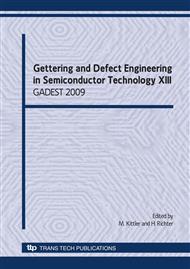p.91
p.95
p.101
p.107
p.115
p.123
p.129
p.135
p.139
Properties of Fast-Diffusing Oxygen Species in Silicon Deduced from the Generation Kinetics of Thermal Donors
Abstract:
The generation of Thermal Donors in Si is a nucleation process controlled by several mobile On clusters. The rate-limiting transitions are found to be O1 O2 and O4 O5. The individual transition rates G12 and G45, and also G23 and G34 are deduced from the experimental data. From the transient variation of the generation rate G(t), the equilibrium concentration of the dimers is found, and with it the dimeric diffusivity is also defined. In samples pre-treated at high T, the G(t) dependence has a maximum, due to quenched-in fast-diffusing oxygen monomers (FDMs). The concentration and diffusivity of FDMs were determined.
Info:
Periodical:
Pages:
115-122
Citation:
Online since:
October 2009
Keywords:
Price:
Сopyright:
© 2010 Trans Tech Publications Ltd. All Rights Reserved
Share:
Citation:


